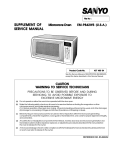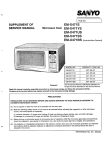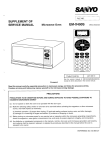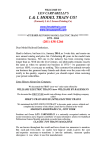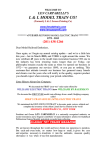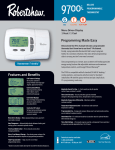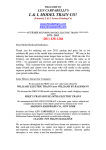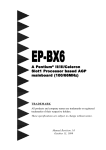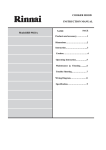Download Sanyo EM-F3400SW Microwave Oven User Manual
Transcript
File No : SER VICE MANUAL SERVICE Micr owave Oven Microwave EM-F3400SW Pr oduct Code No. Product (U.S.A.) 437 450 57 CAUTION WARNING TO SER VICE TECHNICIANS SERVICE PRECAUTIONS TO BE OBSERVED BEFORE AND DURING SERVICING TO AVOID POSSIBLE EXPOSURE TO EXCESSIVE MICROWAVE ENERGY (a) Do not operate or allow the oven to be operated with the door open. (b) Make the following safety checks on all ovens to be serviced before activating the magnetron or other microwave source, and make repairs as necessary : (1) Interlock operation, (2) proper door closing, (3) seal and sealing surfaces (arcing, wear, and other damage), (4) damage to or loosening of hinges and latches, (5) evidence of dropping or abuse. (c) Before turning on microwave power for any service test or inspection within the microwave generating compartments, check the magnetron, wave guide or transmission line, and cavity for proper alignment, integrity, and connections. (d) Any defective or misadjusted components in the interlock, monitor, door seal, and microwave generation and transmission systems shall be repaired, replaced, or adjusted by procedures described in this manual before the oven is released to the owner. (e) A microwave leakage check to verify compliance with the Federal performance standard should be performed on each oven prior to release to the owner. REFERENCE NO. SM-860304 In the area emitting the highest reading, switch the meter to SLOW RESPONSE, and take a reading for minimum of three (3) seconds. We recommended the pattern outline shown below when the door surface is surveyed. CAUTION For micr owave ener gy emission microwave energy On every service calls, check for microwave energy emission, must be made according to the following manner. gy emission Measur ement of ener Measurement energy Measurement must be made with the microwave oven operating at its maximum output and containing a load of 275±15 milliliters of tap water initially at 20o±5o celsius (68 ±9oF) placed within the cavity at the center. NOTE : The water container must be a 600 milliliter beaker and made of an electrically none conductive material such as glass or plastic. The cook tray must be in place when measuring emission. A properly operating door and seal assembly will normally register emission on greater than 4mW/cm2 to allow for measurement uncertainty with the cooking shelf or tray in place. NOTE : Periodically check to be sure that the probe tip is not worn or dirty. The following U.S. standard applies to microwave ovens : 21 CFR 1030.10, Performance Standard for Microwave Ovens. It requires that the power density of the microwave radiation emitted by a microwave oven shall not exceed five (5) milliwatts per square centimeter at any point 5 centimeter (about 2 inches) or more from the external surface of the oven. All microwave ovens exceeding the emission level of 4mW/cm 2 must be reported to Dept. of Service for microwave ovens and the manufacturer immediately and the owner should be told not to use the microwave oven until it has been repaired completely. If a microwave oven is found to operate with the door open, report to Dept. of Service, the manufacturer and CDRH* All repairs must be performed in such a manner that immediately. Also tell the owner not to use the oven. owave ener gy emission ar e minimal. micr are microwave energy *CDRH : Center for Device and Radiological Health. Follow the instructions supplied with a detector being used and performed an R.F. emission test around the door front and edges and all edges and vent of the outer case. The cabinet (wrapper) must be in place and the oven fully assembled. When performing emission survey, with the meter on FAST RESPONSE the movement of a detector probe shall not exceed one (1) inch per second. -i- The interlock monitor switch acts as the final safety switch protecting the customer from microwave radiation. If the interlock monitor switch operates to blow the fuse with interlocks failed, you must replace all interlock switches primary and secondary interlock switches and the monitor switch with new ones because the contacts of those interlock switches may be melted and welded together. - TABLE OF CONTENTS Adjustment Procedures ................................................... Specifications .................................................................. Power Output Measurement ........................................... Precautions and Repair Service Tips .............................. Circuit Diagram ............................................................... 1 2 2 2 3 1 . ADJUSTMENT PROCEDURES TO A VOID POSSIBLE EXPOSURE TO MICROW AVE AVOID MICROWA ENERGY LEAKAGE, THE FOLLOWING ADJUSTMENT OF THE INTERLOCK SWITCHES SHOULD BE MADE ONL Y BY AUTHORIZED ONLY SER VICE PERSONNEL. SERVICE The SANYO service center should have the designated detector to measure the microwave energy leakage after the repair or adjustment. Test Procedures and Troubleshooting .................... Disassembly Instructions ....................................... Exploded View and Parts List ................................ Overall Circuit Diagram .......................................... 4 ~ 10 11 ~ 14 15 ~ 20 21 NOTE : If the interlock monitor circuit operates and at the same time the fuse blows with the door opened, be sure to replace the control circuit board because relay 2 on the control circuit board, the door sensing switch and the electric circuit related on the door sensing switch, which act as Secondary Interlock Switch. Door Latch Lever Stopper NOTE : Detector to be used at the service center is NARDA 8100, 8200 or the equivalent. Door Sensing Switch PRIMAR Y INTERLOCK SWITCH, INTERLOCK PRIMARY MONITOR SWITCH AND DOOR SENSING SWITCH ADJUSTMENT (Figure 1) (1) Loosen 2 screws securing the lever stopper. (2) Adjust the lever stopper position so that it is pushed forward and pull backward until there is about zero gap between the latch lever and switch body on the primary interlock switch and at the same time there is about zero gap between the door latch and the switch body on the door sensing switch when the door latch is securely locked. Interlock Monitor Switch Screws (3) Tighten the lever stopper screws securely. (4) Make sure the interlock monitor switch closes after the primary interlock switch opens when the door is opened very slowly, according to “CHECKOUT PROCEDURE FOR SWITCHES” on page 6. (5) Make sure the interlock monitor switch opens before the primary interlock switch closes when the door is closed very slowly, according to “CHECKOUT PROCEDURE FOR SWITCHES” on page 6. (6) Make sure the microwave energy leakage should be no greater than 4mW/cm2 to allow for measurement uncertainty when measured with a detector. (All service adjustments must be made for minimum microwave energy leakage readings.) Figure 1 -1- Latch Lever Primary Interlock Switch 4 . PRECAUTIONS AND REP AIR SER VICE TIPS REPAIR SERVICE 2 . SPECIFICA TIONS SPECIFICATIONS Rated Power Consumption .. 1480W. Microwave Output ................ 1050W. Frequency ............................. 2,450MHz±50MHz. Power Supply ........................ 120V±12V, 60Hz. Rated Current ....................... 12.9 Amp. Safety Devices ..................... Thermal Fuse open at 332°F (167°C) for Cavity. Thermal Protector open at 252°F (122°C) for Magnetron. Fuse (Cartridge Type 20A) Primary Interlock Switch, Door Sensing Switch and Relay 2. Interlock Monitor Switch. Timer ..................................... Electronic Digital, up to 99 min. 99 sec. Overall Dimensions ................ 205/8”(W) x 161/2”(D) x 113/8”(H) Oven Cavity Size .................. 133/4”(W) x 145/8”(D) x 81/2”(H) Turn Table Diameter .............. 10 7/8” Effective Capacity of Oven Cavity .......................... 1.1 Cubic Feet. Net Weight ........................... Approx. 34.5 Lbs. PRELIMINAR Y PRELIMINARY A. SINCE NEARL Y 2,000 VOL TS EXISTS IN SOME CIRNEARLY VOLTS CUITS OF THIS MICROW AVE OVEN, REP AIRS SHOULD MICROWA REPAIRS BE CARRIED OUT WITH GREA GREATT CARE. B. TO A VOID POSSIBLE EXPOSURE TO MICROW AVE AVOID MICROWA ENERGY LEAKAGE, THE FOLLOWING PRECAUTIONS VICING. MUST BE TTAKEN AKEN BEFORE SER SERVICING. (1) Before the power is applied : (a) Open and close door several times to make sure the primary interlock switch, the interlock monitor switch and the door sensing switch operate properly. (Listen for the clicking sound from the switches). Make sure the interlock monitor switch closes after the primary interlock switch is opens when the door is opened. (See pages 1 and 6). (b) Make sure the perforated screen and the choke dielectric of the door are correctly mounted. (2) After the power is applied : (a) Open and close the door to see if the interlock mechanism operates properly. (b) Check microwave energy leakage with a leakage detector and confirm the energy leakage should be no greater than 4mW/cm2 to allow for measurement uncertainty. 3 . POWER OUTPUT MEASUREMENT NOTE The power output specification, 1050W. on this model is measured with IEC measurement. The power output is measured with two (2) liters water is equivalent to 1050W. in measurement with IEC, when measured with the following power output. (3) Do not operate the unit until it is completely repaired, if any of the following conditions exists : (a) (b) (c) (d) Door does not close firmly against the cavity front. The hinge is broken. The choke dielectric or the door seal is damaged. The door is bent or warped, or there is any other visible damage to the oven that may cause microwave energy leakage. NOTE : Always keep the seal clean. (1) Fill two beakers (glass or plastic) with each one liter of tap water (about 20°C) and measure the water temperature. (Use a thermometer with a 1/10 degree gauge). (e) Make sure that there are no defective parts in the interlock mechanism. (2) Place the beakers side by side in the center of the glass tray. (3) Close the door, set the “TIME” for two minutes. (“200” in the display window). Touch the “START” key and heat the water exactly for two minutes. (4) Take the beakers out, immediately stir the water and measure the water temperature respectively. (f) Make sure there are no defective parts in the microwave generating and transmission assembly. (especially waveguide). (4) The following items should be checked after the unit is repaired : (5) Calculate the temperature rise of water in each beaker. Then calculate the average value of two temperature rises. Output power can be calculated by the equation : Power Output (W) = 70 x ∆t Where ∆t is an average temperature rise in degrees Centigrade. (6) Power Output shall be in the following range : Minimum Maximum Average Temperature Rise 19.6°F (10.9°C) 20.0°F (14.0°C) (a) The interlock monitor switch is connected correctly and firmly. (b) The magnetron gasket on the magnetron is properly positioned. (c) Waveguide and oven cavity are intact (no leakage of microwave energy). (d) The door can be properly closed and the safety switches work properly. Power Output 763W 980W (e) The oven must be stopped when the door is opened or the time is up. (7) Power Output is affected by the line voltage under load. For correct Power Output measurement, the line voltage under load must be 120±1 volts. The oven must not be operated with any of the above components rremoved emoved or bypassed. -2- 5. CIRCUIT DIAGRAM Figure 2 S E C OND A RY INTE RL OC K S W ITC H M A D E C OND ITION • P RIM A RY INTE RL OC K S W ITC H INTE RL OC K M ONITOR S W ITC H D OOR S E NS ING S W ITC H R E L AY 2 C OM C OM C OM C OM NO NC NO NO • • • D OOR OP E N D OOR C L OS E • -3- Filament Windings 6. TEST PROCEDURES AND TROUBLESHOOTING CAUTION - DISCONNECT THE POWER SUPPL Y CORD FROM SUPPLY THE W ALL OUTLET WHENEVER REMOVING THE WALL CABINET FROM THE UNIT UNIT,, PROCEED WITH THE TESTS ONL Y AFTER DISCHARGING THE HIGH ONLY VOL ACITOR AND REMOVING THE LEAD VOLTTAGE CAP CAPACITOR WIRES FROM THE PRIMAR Y WINDING OF THE PRIMARY HIGH VOL VOLTTAGE TRANSFORMER. (SEE FIGURE 3) Secondary Windings Primary Windings Figure 3 A. TEST PROCEDURES COMPONENT CHECKOUT PROCEDURE RESUL RESULTT 1) Check for resistance : Across the filament terminals of the Magnetron with an Ohm-Meter on R x 1 scale. Normal reading : Less than 1 Ohm. Ohm-Meter Figure 4 MAGNETRON 2) Check for resistance : Between each filament terminal of the Magnetron and the chassis ground with an Ohm-Meter on highest scale. Normal reading : Infinite Ohms. Ohm-Meter Figure 5 HIGH-VOLTAGE TRANSFORMER 1) Measure the resistance : With an Ohm-Meter on R x 1 scale. a. Primary winding : b. Filament winding : c. Secondary winding : Normal readings : 2) Measure the resistance : With an Ohm-Meter on highest scale. a. Primary winding to ground. b Filament winding to ground. Normal readings : Approximately 0.38 Ohms. Less than 1 Ohm. Approximately 82.0 Ohms. Ohm-Meter Figure 6 Note : Remove varnish of measured point. -4- Infinite Ohms. Infinite Ohms. COMPONENT HIGH-VOLTAGE CAPACITOR including BLEEDER RESISTOR CHECKOUT PROCEDURE RESUL RESULTT Measure the resistance : Across two terminals with an Ohm-Meter on highest scale. Normal reading : Momentarily indicates several Ohms, and gradually returns to 10 Meg-Ohms. Abnormal reading : Indicates continuity or 10 Meg-Ohms from the beginning. Ohm-Meter Figure 7 Measure the resistance : Across two terminals with an Ohm-Meter on R x 10,000 scale. Ohm-Meter Normal reading : Indicates about the middle position in one direction (forward direction) and infinite ohms in the reverse direction, using meter which is provided with a 9 volt battery. NOTE HIGH-VOLTAGE DIODE - Some digital meter may show over even in a forward direction because low measuring voltage of meter does not allow the meter current to pass through the High Voltage Diode. Abnormal reading : Indicates continuity or infinite Ohms in both directions. Figure 8 Measure the voltage : Between test point TP-1, TP-2 and Ground. (See Control Circuit Board on page 19). CONTROL CIRCUIT BOARD NOTE - Proceed with the check of the Step-Down Transformer, to see if any one of the measured values is different from the specified values. -5- Test Point TP-1 TP-2 Voltage -5V DC -15V DC COMPONENT CHECKOUT PROCEDURE RESUL RESULTT Measure the resistance between terminals of FPC connector after removing it from S101. (Figure 9). TOUCH KEY BOARD NOTE - When reconnecting the FPC connector, make sure the holes on the connector are properly inserted in hooks of the plastic fastener in S101. 5 POWER LEVEL TOTAL QUICK ON 6 1 7 2 8 3 9 PIZZA SLICE S TAR T 4 STOP / CLEAR VEGETABLE FRESH CLOCK DEFROST QUICK DEFROST SOUP / BEVERAGE When touched When not touched Less than 1K Ohms More than 1 MEG Ohms When checking “START” key, connect Ohm-Meter as illustration below. Ohm-Meter MA TRIX CIRCUIT FOR MATRIX TOUCH KEY BOARD FPC CONNECTOR 0 Resistance value MORE + LESS - POTATO FROZEN KITCHEN ENTREE TIMER FROZEN ADD 30 SEC VEGETABLE CUSTOM POPCORN PROGRAMS TERMINALS OF FPC CONNECTOR Figure 9 CHECKOUT PROCEDURE FOR SWITCHES Disconnect the lead wires from the switches and check for the continuity of the switches, connecting an Ohm-Meter to its terminals. SWITCHES (See Figure 1 on page 1) CHECKOUT PROCEDURES DOOR OPEN DOOR CLOSED Primary Interlock Terminals “COM” and “NO” Door Sensing Interlock Monitor CAUTION : Terminals “COM” and “NC” After checking the switches, make sure that the interlock monitor switch is properly connected according to the CIRCUIT DIAGRAM on page 3. -6- -7- b Check power supply voltage on Control Circuit Board. (See page 5) Control Circuit Board. Check 120VAC power supply of connector S1 between Pin 1 and Pin 3 after removing connector S1 from Control Circuit Board. a (1) PROBLEM No display or mis-display in the display window by touching the keys. STEP B. TROUBLESHOOTING Voltage incorrect. Each voltage OK. 120 volts. 0 volt. Check resistance of Touch Key Board. (See page 6) Touch Key Board. Resistance incorrect (ON or OFF). Each resistance OK. Check continuity of Fuse, Thermal Protector for Magnetron, Thermal Protector for Cavity and AC Power Cord. If the Fuse is blown, see “E, REMOVING FUSE” on page 13. SEQUENCE Normal Touch Key Board. Normal Control Circuit Board. Replace Control Circuit Board. Normal Control Circuit Board. Replace Touch Key Board. Correct seating of connector S101 or replace Control Circuit Board. Replace it if necessary. Runs Runs Runs PROBLEM 1-b Runs R E S U LLTT -8- Door Sensing Switch. Touch “START” key and measure voltage between white wire lead and black wire lead for primary winding of H.V. transformer after removing the wire leads from terminals of H.V. Transformer. a (3) PROBLEM Oven does not heat up. Continuity OK. 0 Volts. AC 120 Volts. No continuity. Check contact of Connector S102. CHECK : 1 . Power Supply to Oven. 2 . Primary Interlock Switch. 3 . Thermal Protector for Magnetron and Thermal Protector for Cavity. Check continuity of connector S102 between Pins (O and BL) with the door closed after removing connector S102 from Control Circuit Board. a (2) PROBLEM Cooking operation will not start. STEP Poor contact. Contact OK. SEQUENCE Correct seating. Replace Control Circuit Board. Adjust or replace Door Sensing Switch. (See page 1) Normal contact. Normal Control Circuit Board. Normal Door Sensing Switch. Runs PROBLEM 3-b Runs Runs PROBLEM 3-a R E S U LLTT -9- Check resistance of each winding after removing lead wires. (See page 4) H.V. Transformer. a Check operation of Blower Motor when “START” key is touched. (4) PROBLEM Low microwave power output. b STEP Normal operation. Replace H.V. Transformer. Check H.V. Capacitor or H.V. Diode with an Ohm-Meter after removing lead wires. (See page 5) Normal resistance Normal H.V. Capacitor or H.V. Diode. Normal Magnetron. Normal Blower Motor. Replace Control Normal Control Circuit Board. Circuit Board. Replace Blower Motor. Normal thermal protector for Magnetron or Thermal Protector for Cavity. Replace H.V. Capacitor or H.V. Diode. Replace Magnetron. Resistance incorrect. Replace Thermal Protector for Magnetron or Thermal Protector for Cavity. Normal H.V. Transformer. Defective H.V. Capacitor or H.V. Diode. Normal H.V. Capacitor or H.V. Diode. No Temporarily short operation. across terminals of Thermal Protector for Magnetron or Thermal No Protector for Cavity Measure resistance operation. by using jumper lead. of Blower Motor Approx. 63 ohms. Normal operation. Resistance incorrect. Resistance OK. SEQUENCE Runs Runs Runs PROBLEM 3-b Runs Runs Runs R E S U LLTT - 10 - Set power level at “50”. a H.V. Transformer. Touch “START” key and measure voltage between white wire lead and black wire lead for primary winding of H.V. Transformer after removing the wire leads from terminals of H.V. Transformer. Check normal operation of Control Circuit Board. (6) PROBLEM No buzzing by touching keys and at the end of cooking. a (5) PROBLEM The Magnetron operates on high level when a lower cook power is selected. STEP 120V Voltage cycles on and off. SEQUENCE Replace Control Circuit Board Replace Control Circuit Board Normal Control Circuit Board Normal Control Circuit Board Runs Runs No problem. Measure water temperature rise exactly. R E S U LLTT 7 . DISASSEMBL Y INSTRUCTIONS DISASSEMBLY • OVEN MUST BE DISCONNECTED FROM ELECTRICAL OUTLET WHEN MAKING REPLACEMENTS, REP AIRS, REPAIRS, ADJUSTMENTS AND CONTINUITY CHECKS BEFORE PROCEEDING WITH ANY REP AIR WORK. AFTER REPAIR AIT A DISCONNECTING, W ATT LEAST 1 MINUTE, UNTIL WAIT THE CAP ACITOR IN THE HIGH-VOL CAPACITOR HIGH-VOLTTAGE AREA HAS FULL Y DISCHARGED. FULLY • WHEN REPLACING ANY DOOR MICROSWITCH, REPLACE WITH THE SAME TYPE SWITCH SPECIFIED ON THE P AR TS LIST PAR ARTS LIST.. A. REMOVING DOOR SENSING SWITCH (Figures 1 on page 1, 10-a) (1) Disconnect all wire leads from the door sensing switch. (Figure 1 on page 1) (2) Remove 2 screws securing the lever stopper. B. REMOVING PRIMAR Y INTERLOCK SWITCH AND PRIMARY INTERLOCK MONITOR SWITCH (Figure 10-b) (1) Disconnect all wire leads from primary interlock and Interlock monitor switch. (2) Pull the primary interlock switch or Interlock monitor switch upward at the same time while pushing the switch stoppers to allow a space between the switch body and catches. (3) Make necessary adjustments or replacement of switch by the reversing step (2) and check microwave energy leakage according to “1. ADJUSTMENT PROCEDURES” on page 1, after it is replaced with new one, and check proper operation of it according to “CHECKOUT PROCEDURE FOR SWITCHES” on page 6. (3) Push the door sensing switch upward while pressing adjacent upper switch stopper of lever stopper and lower switch stopper down (Figure 10-a). Switch Stoppers (4) Then remove it by lightly pressing the switch toward you (Figure 10-a). (5) Make necessary adjustments or replacements of the door sensing switch by reversing step (3) and check microwave energy leakage according to “1. ADJUSTMENT PROCEDURES” on page 1, after it is replaced with new one, and check proper operation of it according to “CHECKOUT PROCEDURE FOR SWITCHES” on page 6. Interlock Monitor Switch Primary Interlock Switch Upper Switch Stopper Door Sensing Switch Switch Stoppers Figure 10-b Lower Switch Stopper Figure 10-a Interlock Switch Replacement - when replacing faulty switches, be sure switch mounting tabs are not bent, broken or otherwise deficient in their ability to secure the switches in place. - 11 - C. REMOVING BLOWER MOTOR (Figures 11 (Top View) and 12). Duct (mag. exhaust) (1) Remove screw securing the stay. (2) Disconnect all lead wires from the blower motor and H.V. capacitor. Blower Base Thermal Protector Screw (3) Remove 3 screws securing the blower base and disengage 3 hooks from the rear plate of cavity (Figure 12). (4) Remove 1 screw securing the blower motor with the blower base. D. REMOVING MAGNETRON (Figure 11 (Top View)) Stay Duct (mag. intake) After removing the blower motor : Figur e 11 (T op V iew) Figure (Top View) (1) Remove duct (mag. exhaust). Remove the screw securing the stay. (2) Remove 1 screw securing the thermal protector. (3) Disconnect 2 lead wires from the magnetron. (4) Remove 4 screws securing the magnetron to the waveguide. (5) Take out Magnetron VERY CAREFULLY. Screw NOTE 1. When removing the magnetron from the cavity or wave guide, use a proper care so that the dome of the magnetron does not hit any adjacent parts of microwave oven. 2. Make sure that the contact face of the magnetron gasket is free from any damage or deformation. 3. Adjust the position of the magnetron properly, so that it correctly sits in place and the magnetron gasket is in contact with the mounting rim evenly. 4. While holding the magnetron under this condition, tighten mounting screws or nuts with your fingers temporarily. 5. Further tighten the screws or nuts with a box wrench, giving one or two turns to each of the screws (or nuts) alternatively so that the magnetron is mounted on to the bracket uniformly. 6. After replacing the magnetron, be sure to check the microwave energy leakage with a leakage detector and confirm the leakage is below 4mW/cm2. - 12 - Hook Blower Motor Figure 12 E. REMOVING FUSE Remove the 20A fuse with a screwdriver. -- F. NOTE When replacing the 20A fuse, be sure to use an exact repair part. -- If the 20A fuse blows immediately, check the primary interlock switch, the relay 2 (on the control circuit board) and the interlock monitor switch according to, “CHECKOUT PROCEDURE FOR SWITCHES” on page 6. And make sure to check the microwave energy leakage according to, “1. ADJUSTMENT PROCEDURES” on page 1, when the primary interlock switch, the relay 2 or the interlock monitor switch is adjusted or replaced. -- If the primary interlock switch, the relay 2 and the interlock monitor switch operate properly, determine which of the following is defective : control circuit board, blower motor, high voltage transformer, high voltage capacitor, high voltage diode or magnetron. Control Base REMOVING CONTROL CIRCUIT BOARD (See exploded view on page 18 and Figure 13) (1) Remove the connector S1, S102 and the connector for the relay 2 from the control circuit board. (2) Remove 1 screw securing the control panel complete to the oven cavity. (3) Remove the FPC connector from the connector S101 while grasping up both lever ends of the plastic fastener. Control Frame Figure 13 Control Sheet Control Frame (4) Remove 2 screws securing the control circuit board to the control base. (5) Lift up the control circuit board from its lower side and take it out from the control base. Touch Key Board G. REMOVING TOUCH KEY BOARD (Figure 14) After removing the control circuit board : (1) Remove control base while lifting it up at the right side and take it out from the control frame. (2) Remove control sheet which is glued to touch key board. (3) Remove the touch key board which is held on the control base bracket with the adhesive tape. Figure 14 - 13 - H. REMOVING DOOR J. REMOVING CA VITY COVER CAVITY (Figure 16) (1) Remove 2 hex nuts securing the upper hinge. (1) Remove a screw from the cavity compartment. (2) Tilt the top of the door toward you. (3) Lift up the door to remove it. NOTE - After replacing the door, be sure to check that the primary interlock switch, the door sensing switch and the interlock monitor switch operate normally. (See page 1). Cavity Cover - After replacing the door, check for microwave energy leakage with a leakage detector. Microwave energy leakage must be below the limit of 4mW/cm2 to allow for measurement uncertainty. Screw I. DISASSEMBLING DOOR (Figure 15) Figure 16 (1) Insert a thin flat-blade screwdriver between the choke dielectric and the door main frame and lift up the choke dielectric to release hooks one by one. (Figure 15). K. REMOVING TURNT ABLE MOTOR COVER TURNTABLE (2) Remove the choke dielectric. (Figure 17) (3) To detach the door cover, insert a thin flat-blade screwdriver between door cover and door panel and release the projections inside door cover. (1) Turn over the oven on its back. (4) To detach the door panel, insert a thin flat-blade screwdriver between the door cover and door main frame. Hooks (2) Cut the 6-joints of the bottom plate using diagonal pliers (nipper). (3) Separate the motor cover from bottom plate. (4) Remove 2 screws securing turntable motor to the cavity and take it out. Note : Bent the cut joints inside slightly for safety and be careful of sharp edge. Hooks Hooks 6 Joints Motor Cover Bottom Plate Door Main Frame Choke Dielectric Hooks Figure 15 NOTE - The choke dielectric may be damaged when it is removed. When reinstalling it replace it with new ones if it is damaged. - After installing the door in place, check for microwave energy leakage with a detector. Microwave energy leakage must be below the limit of 4mW/cm2 to allow for measurement uncertainty. Figure 17 - 14 - 8 . EXPLODED VIEW AND P AR TS LIST PAR ARTS CAVITY PARTS *** Key No. 1 2 3 4 5 6 7 8 9 10 11 12 13 ALL SERVICE ON MICROWAVE OVENS SHOULD BE PERFORMED BY A QUALIFIED TECHNICIAN USING APPROVED TESTING EQUIPMENT. CUSTOMERS SHOULD NOT ATTEMPT TO REPLACE PARTS IDENTIFIED BY A TRIPLE ASTERISK (***). Part No. 617 411 411 617 411 617 617 411 617 617 411 617 411 228 082 160 171 160 228 221 010 138 221 011 180 089 Description 8321 5201 6007 6863 6106 8345 3590 5808 5601 6089 0802 6137 2500 Cabinet SCR TPG TRS 4 x 10 Z1 SCR TPG TRS + SRT 4 x 10 Z1 Power Cord SCR S-T TRS + SRT 4 x 10 Z1 Oven Cavity*** (Not Service Part) Gear Motor SCR EVR PAN 4 x 10 Z1 Bottom Plate*** (Not Service Part) Plastic Foot with Canoe Clip Bolt Hex + SW + W5 x 14 Z1*** Hinge, Lower*** Washer F 5 x 10 x 0.8 Q’ty Key No. 1 8 2 1 1 1 1 2 1 4 2 1 1 14 15 16 17 18 19 20 21 22 23 24 25 26 - 15 - Part No. 617 617 617 617 617 617 411 411 617 617 120 220 204 073 204 162 069 006 200 080 Description 8481 9401 9489 5889 9403 1938 1707 6604 0381 5315 617 229 9013 Q’ty Insulation Sheet Turn Table Shaft Roller Base Assy Rotating Tray Antenna Complete Cavity Cover SCR TPG TRS 4 x 6 DA SCR TPG PAN 3 x 6 Z1 Thermal Fuse 167oC Special Washer 1 1 1 1 1 1 1 1 1 1 Special Screw 2 SWITCHES AND MICROWAVE PARTS *** Key No. ALL SERVICE ON MICROWAVE OVENS SHOULD BE PERFORMED BY A QUALIFIED TECHNICIAN USING APPROVED TESTING EQUIPMENT. CUSTOMERS SHOULD NOT ATTEMPT TO REPLACE PARTS IDENTIFIED BY A TRIPLE ASTERISK (***). Part No. Description 1 2 3 4 5 6 7 8 9 10 11 411 617 617 411 617 415 423 617 617 617 617 082 229 199 006 129 002 020 233 221 162 197 5201 9020 8283 6604 1001 9508 3408 0006 3606 1990 6670 12 13 14 15 16 617 411 617 617 617 182 011 229 005 230 2373 5609 7903 5147 2713 SCR TPG TRS 4 x 10 Z1 H.V Transformer,*** N6T-P410 Stay, Cavity & Magnetron SCR TPG PAN 3 x 6 Z1 Thermostat, Magnetron 135oC Magnetron, 2M253H(M)N*** Fuse, 125V 20A Fuse Holder Lead Wire Ass’y (including Diode) Blower Base H.V Capacitor including Resistor, 0.97uf 2.2KV Capacitor Band Bolt Hex 4 x 10 Z1 Duct, Mag. Exhaust Lamp, 120V 20W Lamp Socket Q’ty 9 1 1 1 1 1 1 1 1 1 1 1 4 1 1 1 Key No. Part No. 17 18 19 20 21 617 411 617 617 617 22 617 221 4061 23 617 221 4078 24 25 26 27 28 29 617 411 411 617 617 - 16 - 197 082 196 245 221 Description 245 102 129 117 124 7417 5201 8507 6256 4078 6096 5907 5805 3505 3796 Q’ty Blower Motor SCR TPG TRS 4 x 10 Z1 Blower Fan Latch Lever*** Micro Switch,*** Primary Interlock AM51630C53F2 Micro Switch,*** Interlock Monitor AM50620C53 Micro Switch,*** Door Sensing AM51630C53F2 1 2 1 1 1 Lever Stopper*** SCR ETG TRS 4 x 10 N2 SCR TPG BIN 3 x 10 Z1 Harness, Door Sensing Lead Wire Ass’y 1 2 1 1 1 1 1 DOOR PARTS *** Key No. ALL SERVICE ON MICROWAVE OVENS SHOULD BE PERFORMED BY A QUALIFIED TECHNICIAN USING APPROVED TESTING EQUIPMENT. CUSTOMERS SHOULD NOT ATTEMPT TO REPLACE PARTS IDENTIFIED BY A TRIPLE ASTERISK (***). Part No. Description 1 2 3 617 229 2403 617 181 4170 617 229 2007 4 617 124 0948 Door Cover*** Door Panel*** Door Main Frame*** (Also order Door Sheet when replacing Door Main Frame) Choke Dielectric*** Q’ty Key No. 1 1 1 5 6 7 8 9 10 1 - 17 - Description Part No. 617 411 617 411 617 617 222 054 180 011 101 179 0123 1903 6151 0802 1494 2478 Door Sheet Nut Hex + Flg W / SRT 5*** Hinge, Upper*** Bolt Hex + SW + W 5 x 14*** Spring*** Door Latch*** Q’ty 1 2 1 2 1 1 CONTROL PANEL PARTS *** Key No. ALL SERVICE ON MICROWAVE OVENS SHOULD BE PERFORMED BY A QUALIFIED TECHNICIAN USING APPROVED TESTING EQUIPMENT. CUSTOMERS SHOULD NOT ATTEMPT TO REPLACE PARTS IDENTIFIED BY A TRIPLE ASTERISK (***). Part No. Description 1 617 230 7787 2 617 233 5872 3 617 229 3646 Control Sheet*** (Also order Touch Key Board when replacing Control Sheet) Touch Key Board*** (Also order Control Sheet when replacing Touch Key Board) Control Frame*** Q’ty 1 1 1 PRINTED MATTER (Items Not Illustrated) Key No. Part No. Description 617 232 7594 Operating Instructions (English / Spanish) Carton Box Complete Name Plate 617 230 9095 617 230 7664 Q’ty 1 1 1 - 18 - Key No. 4 5 6 7 8 9 Part No. 617 411 617 411 617 617 151 160 230 129 080 229 Description 4377 6205 2324 5805 9559 3691 Control Base*** SCR TPG TRS+SRT 4 x 10 Z1 Power & Control Circuit Board*** SCR TPG BIN 3 x 10 Z1 Spring, Door Release Lever*** Door Release Lever*** Q’ty 1 1 1 1 1 1 CONTROL CIRCUIT BOARD (Part No. 617 230 2324 2324) 40800 - 19 - CONTROL CIRCUIT BOARD (Part No. 617 230 2324 2324) Key No. Order Part No. Description Q’ty 409 468 0209 Order Part No. Description Q’ty R901,906, 909 R903 401 037 5608 MT-Glaze, 10K ohms +-1%, 10W. MT-Glaze, 3.3K ohms +-1%, 10W. 3 R902,905, 907, 908 R904 401 038 6406 MT-Glaze, 4.7K ohms +-1%, 10W. MT-Glaze, 820 ohms +-1%, 10W. 4 R106 401 012 4404 1 R101,112 401 012 5609 Carbon, 100 ohms +-5%, 1/4W. Carbon, 1K ohms +-5%, 1/4W. R11 ~ 14 401 013 4106 4 R58 401 013 6308 Carbon, 120 ohms +-5%, 1/4W. Carbon, 12K ohms +-5%, 1/4W. R105 401 016 4707 1 R107,108 401 016 9603 Carbon, 22K ohms +-5%, 1/4W. Carbon, 27 ohms +-5%, 1/4W. R109 401 018 2701 1 R103,104, 51 ~ 53 401 020 2805 Carbon, 330 ohms +-5%, 1/4W. Carbon, 47K ohms +-5%, 1/4W. RESISTORS. INTEGRATED CIRCUIT IC11 Key No. IC LM8847B-1A43. 1 TRANSISTORS Q901 Q103 405 138 8506 405 035 4809 TR FMA9A. 2SC1685-Q-TP. 1 1 Q101,102 405 082 4609 DTA123YS-TP. 2 DIODES D11 D101~106 108 407 012 0200 407 012 4406 1N4002-TP. 1SS133-T77. 1 7 ZD101 ZD11 407 132 2306 407 056 8507 HZS3.9ENB2. RD5.1ESB2. 1 1 401 038 3603 401 039 0304 1 1 2 1 2 5 RESISTOR BLOCK CAPACITORS C104, 105, 108 403 069 1207 C103, 106, 107 C101 403 142 5306 C12 403 105 3806 C11 403 152 7208 403 049 2606 Ceramic, 1000PK, +-5%, 50V. 3 RB101 617 010 3558 Resistor Network 1 Ceramic, 0.01mfd, +-5%, 50V. Electrolytic, 1mfd, +-20%, 50V. 3 RB902 RB901 402 080 7700 401 083 2108 MT-Glaze, 10K x 4 MT-Glaze, 4.7K x 7 1 1 1 MISCELLANEOUS Electrolytic, 47mfd, +-20%, 10V. Electrolytic, 1000mfd, +-20%, 25V. 1 1 BZ1 420 000 6800 Buzzer, PKM22EPT. 1 VST1 LCD1 407 118 5505 617 209 2218 Varistor ENC 471D-10A. Display Tube. 1 1 RL1 RL2 617 201 3978 617 141 0549 Relay, G5N-1A-DC12. Relay, DU12D1-1PR. 1 1 RS1 S1 617 128 3372 617 169 4109 Ceramic Oscillator. Connector. 1 1 S101 S102 617 126 8959 617 111 1392 Connector. Connector. 1 1 PT1 617 230 4984 1 2 617 178 4268 Step-Down Transformer. P6K-P410 Part Base. JB1, 2 J9 ~ 13 16, 17 617 132 5744 617 079 4299 Noise Filter. Jumper. 2 7 J101~ 103 617 079 4237 Jumper. 3 - 20 - 1 9 . OVERALL CIRCUIT DIAGRAM - 21 -























